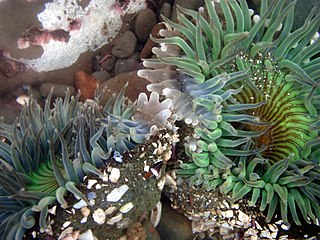
Competition is an interaction between organisms or species in which both the organisms or species are harmed. Limited supply of at least one resource used by both can be a factor. Competition both within and between species is an important topic in ecology, especially community ecology. Competition is one of many interacting biotic and abiotic factors that affect community structure. Competition among members of the same species is known as intraspecific competition, while competition between individuals of different species is known as interspecific competition. Competition is not always straightforward, and can occur in both a direct and indirect fashion.
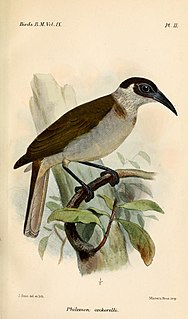
The New Britain friarbird is a species of bird in the family Meliphagidae. It is endemic to Papua New Guinea.

The Cockerell's fantail or white-winged fantail is a species of bird in the family Rhipiduridae. It is found in Bougainville Island and the Solomon Islands.

The white-streaked honeyeater is a species of bird in the family Meliphagidae. It is monotypic within the genus Trichodere. It is endemic to Cape York Peninsula. Its natural habitat is subtropical or tropical dry forest.
Friseria is a genus of moths in the family Gelechiidae.
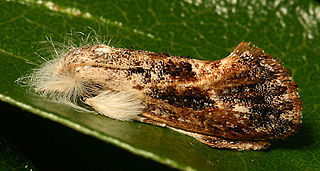
Acrolophus is a genus of moths in the family Acrolophidae, with, typically, great individual variation within species in color pattern, making field identification of many individuals difficult or impossible. It was described by Felipe Poey in 1832.

Bactericera cockerelli, also known as the potato psyllid, is a species of psyllid native to southern North America. Its range extends from Central America north to the American Pacific Northwest and parts of Manitoba. It is restricted to the western part of the continent. As its name suggests, it is commonly found on potato and tomato crops, but has a species range that encompasses over 40 species of solanaceous plants and as many as 20 genera. Breeding hosts are generally recognised as being restricted primarily to Solanaceae, including important crop and common weed species, and a few species of Convolvulaceae, including bindweed and sweet potato. On some plants, especially potato, feeding of the nymphs causes a condition called psyllid yellows, presumed to be the result of a toxin. Both nymphs and adults can transmit the bacterium Candidatus Liberibacter.
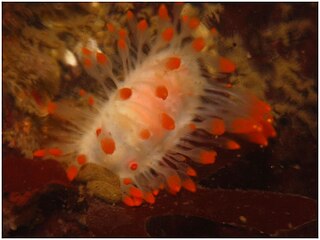
Limacia cockerelli is a species of sea slug, a dorid nudibranch, a shell-less marine gastropod mollusc in the family Polyceridae.
Prolyonetia is an extinct genus of moths in the family Lyonetiidae. The single species Prolyonetia cockerelliKusnetzov, 1941, has been described from Baltic amber.

Cauchas is a genus of the fairy longhorn moth family (Adelidae). Among these, it belongs to subfamily Adelinae. The taxon "Cauchas" Philipp Christoph Zeller 1839 was originally created as a subgenus of the genus Adela Latreille 1796 but was raised to the genus level in 1980 by Ebbe Schmidt Nielsen.
Bombus cockerelli, Cockerell's bumblebee, is a yellow and black bumblebee known only from fewer than 30 specimens, collected at a few high-altitude localities in the White Mountains of New Mexico, all within an area of less than 300 square miles (780 km2), giving it the smallest range of any of the ~250 species of bumblebees in the world.
Acrolophus cockerelli is a moth of the family Acrolophidae. It is found in North America, including Arizona, Nevada, New Mexico, Oklahoma, Oregon and Texas.
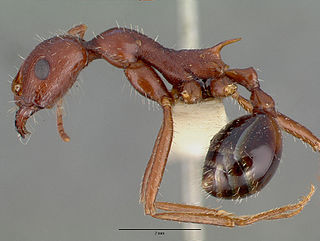
Novomessor cockerelli is a species of ant in the subfamily Myrmicinae. It is native to the deserts of the Southwestern United States and Mexico. It lives in large underground colonies in which there is a single queen. The worker ants leave the nest daily to forage for seeds, plant material and dead insects.
Friseria cockerelli, the mesquite webworm moth, is a moth of the family Gelechiidae. It is found in Mexico and the southern United States, where it has been recorded from Texas, New Mexico, Arizona, Colorado, California, Oklahoma and Nevada.

Novomessor albisetosus, also known as the desert harvester ant, is a species of ant found in the United States and Mexico. A member of the genus Novomessor in the subfamily Myrmicinae, it was first described by Austrian entomologist Gustav Mayr in 1886. It was originally placed in the genus Aphaenogaster, but a recent phylogenetic study concluded that it is genetically distinct and should be separated. It is a medium-sized species, measuring 6 to 8.5 millimeters and has a ferruginous body color. It can be distinguished from other Novomessor species by its shorter head and subparallel eyes.
Dichorda rectaria is a species of emerald moth in the family Geometridae. It is found in North America.
Herpyllus cockerelli is a species of ground spider in the family Gnaphosidae. It is found in the United States and Mexico.
Xestoleptura cockerelli is a species of flower longhorn in the beetle family Cerambycidae. It is found in North America.
Protandrena cockerelli is a species of bee in the family Andrenidae. It is found in North America.
Pseudaulacaspis cockerelli, known generally as false oleander scale, is a species of armored scale insect in the family Diaspididae. Other common names include the fullaway oleander scale, magnolia white scale, mango scale, oleander scale, and oyster scale. It is found in Europe.









